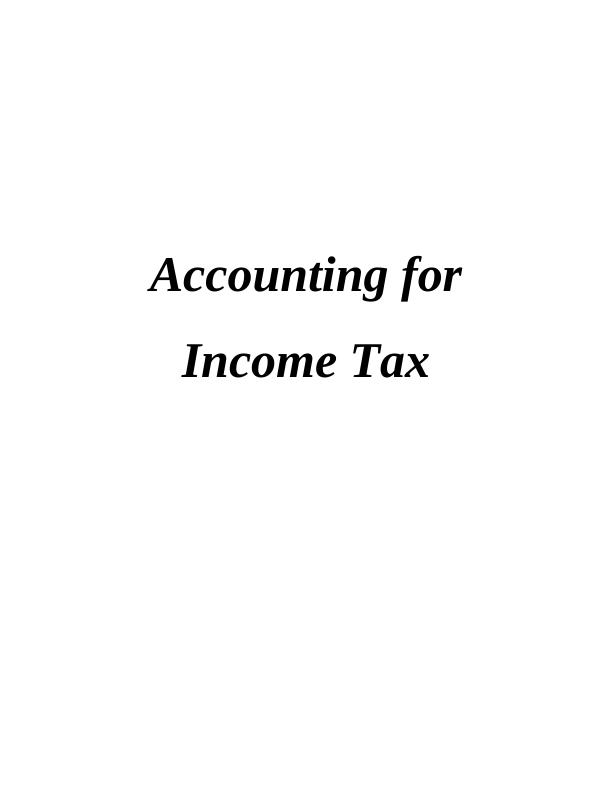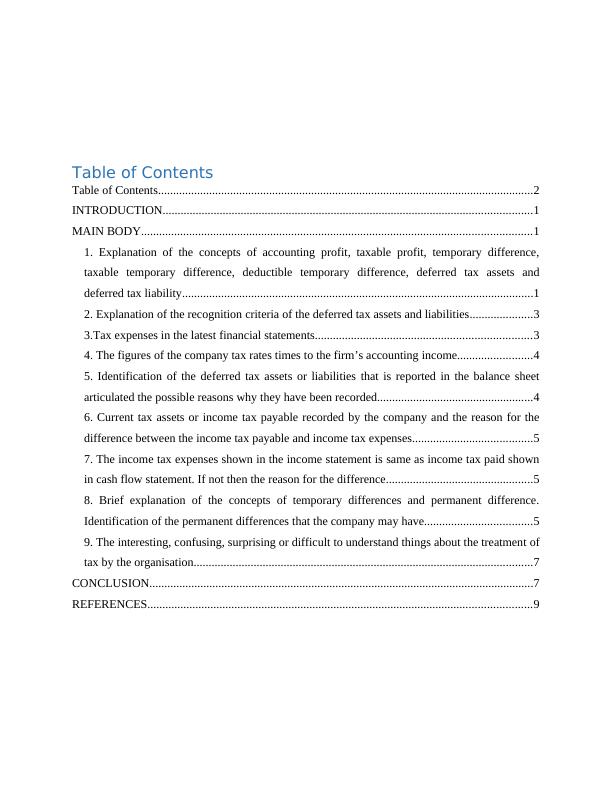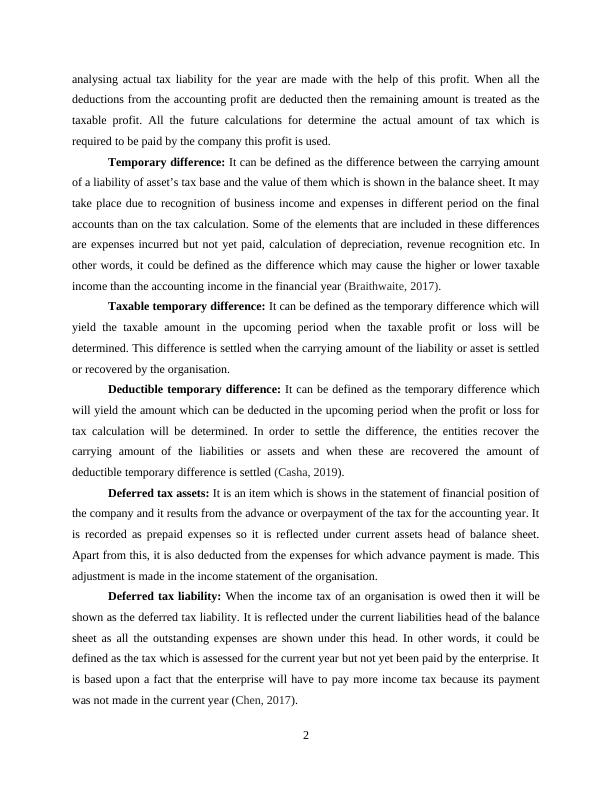Accounting for Income Tax: Concepts and Analysis
Added on 2023-01-11
11 Pages3931 Words38 Views
Accounting for
Income Tax
Income Tax

Table of Contents
Table of Contents.............................................................................................................................2
INTRODUCTION...........................................................................................................................1
MAIN BODY..................................................................................................................................1
1. Explanation of the concepts of accounting profit, taxable profit, temporary difference,
taxable temporary difference, deductible temporary difference, deferred tax assets and
deferred tax liability.....................................................................................................................1
2. Explanation of the recognition criteria of the deferred tax assets and liabilities.....................3
3.Tax expenses in the latest financial statements........................................................................3
4. The figures of the company tax rates times to the firm’s accounting income.........................4
5. Identification of the deferred tax assets or liabilities that is reported in the balance sheet
articulated the possible reasons why they have been recorded....................................................4
6. Current tax assets or income tax payable recorded by the company and the reason for the
difference between the income tax payable and income tax expenses........................................5
7. The income tax expenses shown in the income statement is same as income tax paid shown
in cash flow statement. If not then the reason for the difference.................................................5
8. Brief explanation of the concepts of temporary differences and permanent difference.
Identification of the permanent differences that the company may have....................................5
9. The interesting, confusing, surprising or difficult to understand things about the treatment of
tax by the organisation.................................................................................................................7
CONCLUSION................................................................................................................................7
REFERENCES................................................................................................................................9
Table of Contents.............................................................................................................................2
INTRODUCTION...........................................................................................................................1
MAIN BODY..................................................................................................................................1
1. Explanation of the concepts of accounting profit, taxable profit, temporary difference,
taxable temporary difference, deductible temporary difference, deferred tax assets and
deferred tax liability.....................................................................................................................1
2. Explanation of the recognition criteria of the deferred tax assets and liabilities.....................3
3.Tax expenses in the latest financial statements........................................................................3
4. The figures of the company tax rates times to the firm’s accounting income.........................4
5. Identification of the deferred tax assets or liabilities that is reported in the balance sheet
articulated the possible reasons why they have been recorded....................................................4
6. Current tax assets or income tax payable recorded by the company and the reason for the
difference between the income tax payable and income tax expenses........................................5
7. The income tax expenses shown in the income statement is same as income tax paid shown
in cash flow statement. If not then the reason for the difference.................................................5
8. Brief explanation of the concepts of temporary differences and permanent difference.
Identification of the permanent differences that the company may have....................................5
9. The interesting, confusing, surprising or difficult to understand things about the treatment of
tax by the organisation.................................................................................................................7
CONCLUSION................................................................................................................................7
REFERENCES................................................................................................................................9

INTRODUCTION
Accounting can be defined as the process of recording all the transactions that were made
by an organisation during a financial year. It is very important for all the entities to record all of
them properly as it can facilitate to analyse actual performance and position of business.
Accounting for income tax can be defined as the procedure which is followed to analyse the
taxation liability of the entity for the incomes that are generated in the financial year. It is very
important for enterprises to follow all the specific guidelines of the accounting board so that all
the activities related to it could be performed systematically (Adapa, Rindfleish and Sheridan,
2016). Main of this report is to analyse the process which is followed by a listed company to
calculate the tax liabilities so that its knowledge could be enhanced. The enterprise which is
selected for this purpose is Angel Seafood Holdings Ltd. It is focused on producing farms clean,
organic, green, and sustainable oyster which are sold in Australia as well as different countries in
the world. It is listed on Australian Stock Exchange. This assignment covers various topics such
as discussion of different elements such as taxable profit, deferred tax liability, deductible
temporary difference, tax expenses of the firm, identification of deferred tax assets or liabilities,
current tax assets etc. Apart from this, discussion of temporary and permanent difference along
with interesting, surprising or difficult to understand elements in the annual report which are
analysed while treating the tax are also covered in this report.
MAIN BODY
1. Explanation of the concepts of accounting profit, taxable profit, temporary difference, taxable
temporary difference, deductible temporary difference, deferred tax assets and deferred tax
liability
Accounting profit: It can be defined as the total earnings of an organisation and in order
to calculate it regulation and principles of GAAP are required to be follows. All the costs that are
related to business are deducted from the total incomes so that accurate accounting profits could
be determined. Some of the costs are interest, tax, operating expenses, depreciation etc. All of
them are known as explicit costs on running a business venture so that all the long-term business
goals could be accomplished (Arnold, Ault and Cooper, 2019).
Taxable profit: The profit which is used for the purpose of calculation of tax for the
accounting year is known as taxable profit. All the calculation which are made for the purpose of
1
Accounting can be defined as the process of recording all the transactions that were made
by an organisation during a financial year. It is very important for all the entities to record all of
them properly as it can facilitate to analyse actual performance and position of business.
Accounting for income tax can be defined as the procedure which is followed to analyse the
taxation liability of the entity for the incomes that are generated in the financial year. It is very
important for enterprises to follow all the specific guidelines of the accounting board so that all
the activities related to it could be performed systematically (Adapa, Rindfleish and Sheridan,
2016). Main of this report is to analyse the process which is followed by a listed company to
calculate the tax liabilities so that its knowledge could be enhanced. The enterprise which is
selected for this purpose is Angel Seafood Holdings Ltd. It is focused on producing farms clean,
organic, green, and sustainable oyster which are sold in Australia as well as different countries in
the world. It is listed on Australian Stock Exchange. This assignment covers various topics such
as discussion of different elements such as taxable profit, deferred tax liability, deductible
temporary difference, tax expenses of the firm, identification of deferred tax assets or liabilities,
current tax assets etc. Apart from this, discussion of temporary and permanent difference along
with interesting, surprising or difficult to understand elements in the annual report which are
analysed while treating the tax are also covered in this report.
MAIN BODY
1. Explanation of the concepts of accounting profit, taxable profit, temporary difference, taxable
temporary difference, deductible temporary difference, deferred tax assets and deferred tax
liability
Accounting profit: It can be defined as the total earnings of an organisation and in order
to calculate it regulation and principles of GAAP are required to be follows. All the costs that are
related to business are deducted from the total incomes so that accurate accounting profits could
be determined. Some of the costs are interest, tax, operating expenses, depreciation etc. All of
them are known as explicit costs on running a business venture so that all the long-term business
goals could be accomplished (Arnold, Ault and Cooper, 2019).
Taxable profit: The profit which is used for the purpose of calculation of tax for the
accounting year is known as taxable profit. All the calculation which are made for the purpose of
1

analysing actual tax liability for the year are made with the help of this profit. When all the
deductions from the accounting profit are deducted then the remaining amount is treated as the
taxable profit. All the future calculations for determine the actual amount of tax which is
required to be paid by the company this profit is used.
Temporary difference: It can be defined as the difference between the carrying amount
of a liability of asset’s tax base and the value of them which is shown in the balance sheet. It may
take place due to recognition of business income and expenses in different period on the final
accounts than on the tax calculation. Some of the elements that are included in these differences
are expenses incurred but not yet paid, calculation of depreciation, revenue recognition etc. In
other words, it could be defined as the difference which may cause the higher or lower taxable
income than the accounting income in the financial year (Braithwaite, 2017).
Taxable temporary difference: It can be defined as the temporary difference which will
yield the taxable amount in the upcoming period when the taxable profit or loss will be
determined. This difference is settled when the carrying amount of the liability or asset is settled
or recovered by the organisation.
Deductible temporary difference: It can be defined as the temporary difference which
will yield the amount which can be deducted in the upcoming period when the profit or loss for
tax calculation will be determined. In order to settle the difference, the entities recover the
carrying amount of the liabilities or assets and when these are recovered the amount of
deductible temporary difference is settled (Casha, 2019).
Deferred tax assets: It is an item which is shows in the statement of financial position of
the company and it results from the advance or overpayment of the tax for the accounting year. It
is recorded as prepaid expenses so it is reflected under current assets head of balance sheet.
Apart from this, it is also deducted from the expenses for which advance payment is made. This
adjustment is made in the income statement of the organisation.
Deferred tax liability: When the income tax of an organisation is owed then it will be
shown as the deferred tax liability. It is reflected under the current liabilities head of the balance
sheet as all the outstanding expenses are shown under this head. In other words, it could be
defined as the tax which is assessed for the current year but not yet been paid by the enterprise. It
is based upon a fact that the enterprise will have to pay more income tax because its payment
was not made in the current year (Chen, 2017).
2
deductions from the accounting profit are deducted then the remaining amount is treated as the
taxable profit. All the future calculations for determine the actual amount of tax which is
required to be paid by the company this profit is used.
Temporary difference: It can be defined as the difference between the carrying amount
of a liability of asset’s tax base and the value of them which is shown in the balance sheet. It may
take place due to recognition of business income and expenses in different period on the final
accounts than on the tax calculation. Some of the elements that are included in these differences
are expenses incurred but not yet paid, calculation of depreciation, revenue recognition etc. In
other words, it could be defined as the difference which may cause the higher or lower taxable
income than the accounting income in the financial year (Braithwaite, 2017).
Taxable temporary difference: It can be defined as the temporary difference which will
yield the taxable amount in the upcoming period when the taxable profit or loss will be
determined. This difference is settled when the carrying amount of the liability or asset is settled
or recovered by the organisation.
Deductible temporary difference: It can be defined as the temporary difference which
will yield the amount which can be deducted in the upcoming period when the profit or loss for
tax calculation will be determined. In order to settle the difference, the entities recover the
carrying amount of the liabilities or assets and when these are recovered the amount of
deductible temporary difference is settled (Casha, 2019).
Deferred tax assets: It is an item which is shows in the statement of financial position of
the company and it results from the advance or overpayment of the tax for the accounting year. It
is recorded as prepaid expenses so it is reflected under current assets head of balance sheet.
Apart from this, it is also deducted from the expenses for which advance payment is made. This
adjustment is made in the income statement of the organisation.
Deferred tax liability: When the income tax of an organisation is owed then it will be
shown as the deferred tax liability. It is reflected under the current liabilities head of the balance
sheet as all the outstanding expenses are shown under this head. In other words, it could be
defined as the tax which is assessed for the current year but not yet been paid by the enterprise. It
is based upon a fact that the enterprise will have to pay more income tax because its payment
was not made in the current year (Chen, 2017).
2

End of preview
Want to access all the pages? Upload your documents or become a member.
Related Documents
Corporate Accounting Individual Projectlg...
|11
|3780
|21
Corporate Accounting: Analysis of Deferred Tax Assets and Liabilities of PWR Holdings Limitedlg...
|16
|3722
|340
Corporate Accounting: Concepts and Analysislg...
|22
|4039
|98
Corporate Finance And Accounting Assesmentlg...
|11
|563
|15
Corporate Accounting Assesment Analysislg...
|18
|4369
|18
International Corporate Taxlg...
|6
|937
|88
